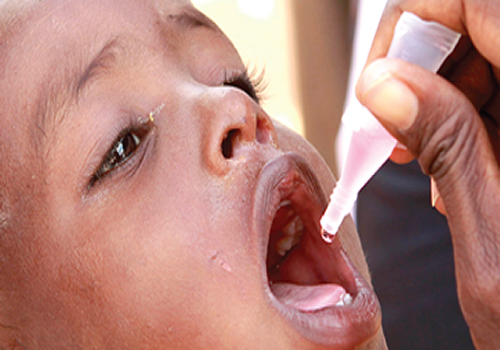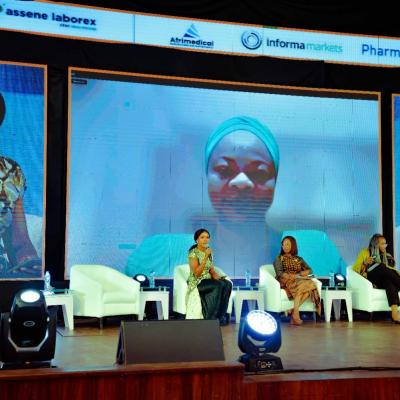Apart from stifling whatever is left of his resolve, her shocking demise has left the young man looking like a pale shadow of his old, vibrant self. It has been a season of emotional and psychological trauma for him and his aged mother, who had become a recluse.
“We thought Amina would win the battle against the disease,” he said, battling tears. “But she died, just like the two others,” he added before eventually succumbing to his emotions. A stream of tears cascaded down his cheek – the sight of a man bruised from deep within.
A modest but happy family, Umar and his siblings both nursed great ambitions for the future even though they were born into an environment where deprivation was rife.
They remained resolute in their pursuit of knowledge and opportunities despite the financial difficulties of the household. They were content with life. But that was before the outbreak and spread of meningitis to their community in northern Nigeria and other parts of the country. The disease took away their dreams and joy as a family.
His narration and sad recollection touch the heart deeply, but beyond Umar’s, several other families were severely affected, decimating them in numbers and sending deep fears among those alive.
When our correspondent visited Maradun, Bindin and other villages in Zamfara State, where several other families were also affected, it was sad tales across the villages.
Worse still, for a disease that is transmissible through the air, rampant with overcrowding and spreads rapidly through physical contact, the number of affected states soon rose from one (Zamfara – starting with one local government) to 15, with severity recorded in Katsina, Sokoto, Kebbi and Niger within a few weeks. And 25 states were affected eventually.
According to the Nigeria Centre for Disease Control, as of March 28, 2017, no fewer than 282 persons had died of the outbreak, including children – the worst hit; women and other adults.
In a daring and worrisome progression, the number of deaths soon rose from 282 in March 2017 to 1,158 deaths by June 2, 2017, which was just about two months after.
What made the deaths, which snuffed life out of children and adults alike, so painful is that the deaths were preventable.
But, Umar’s siblings – Zainab, Neemah and Amina and many others could have won their battles against the epidemic had the Federal Vaccines Production Laboratory located in Yaba, Lagos, been up and running.
Claiming over 1,158 lives between December 2016 and June 2017 as a result of inadequate supply of vaccine to the affected communities and individuals, experts say the deaths could have been curbed had the production laboratory established around 1948 been as vibrant as it was back then.
A vaccine laboratory that once saved lives
In the months and years following its creation in 1948, the FVPL, Yaba, used to be the envy of other West African nations especially due to its cutting-edge technology and expertise in manufacturing vaccines in needed quantity whenever required. Rabbies, small pox, yellow fever and even other more ruthless vaccine-preventable diseases, the laboratory had the wand to prevent, and if need be, extinguish them at the time, a fact recently confirmed by President of the Nigerian Medical Association, Prof. Mike Ogirima.
For instance, during the yellow fever outbreak in Nigeria between 1986 and 1987, a scientist, identified simply as Jose, who worked in the lab at the time, told our correspondent that other affected states across the federation came to the laboratory to get vaccines.
A report by the United States National Library of Medicine stated that in 1950, Nigeria had a record of 67.2 cases of smallpox per 100,000, but that shortly after, the incidence had dropped to 29.7 cases due to the production of over five million doses of vaccine at the FVPL in Yaba, leading to the eradication of the ailment at the time.
Even when smallpox resurfaced in Ibadan in 1957, it was quickly contained by emergency vaccination. And when it came up again in Abakaliki (now the capital of Ebonyi State) in 1967, when the population of eastern Nigeria was about 12 million, targeted vaccination, courtesy of the vaccines produced at the lab in Yaba, helped to contain the spread and save many lives.
Since then, Nigeria has not had any incidence of smallpox.
Experts say vaccination can be used very effectively to prevent infection, and this was the strategy that was used to eradicate the disease during the 20th century.
Jose, who worked in the lab before it folded up, said, “Things were moving fine at that time. It was interesting and exciting seeing lives being saved by virtue of what we were producing. Our vaccines were one of the best and we even exported some.
He said, “Then, I remember we had about six rhesus monkeys as experimental animals for testing yellow fever. Rhesus monkeys are special specie of monkeys that are susceptible to yellow fever and develop similar symptoms as severe as those observed in humans. We had other experimental animals that we were breeding for the vaccine production, because at different stages, you use different animals to check for quality control. So, it was a beehive of activities.”
“The other popular vaccine lab close to us was the Institut Pasteur at Dakar, Senegal. So, Nigeria had it good at that time, and we were always ready, if anything came up.”
But sadly, all these now amount to the glory of the heyday as the laboratory has been under lock and activities grounded since 1991. Since then, Nigeria has continued to import vaccines 100 per cent, while the facilities in the lab rot away.
FVPL’s journey to the bottom
In a chilling revelation on how the lab went under, Jose said in 1991 when the management of the lab, under the Federal Ministry of Health, was carrying out an upgrade of the lab, including the replacement of some equipment, so it could meet international standards, they had to stop production. But after the upgrade, the lab never returned to work.
He recalled, “We brought in new machines from Germany, and we also had donations from some organisations. Some Germans were flown in to install them.
“While the installation was going on, we couldn’t produce, because vaccines are produced in a sterile environment. Thus, we the staff members were taken through in-house training, to teach us on the use of the new machines and modern practices. But after the upgrade, we just found that we never got back to production, till date.
“Till today, there are some of the newly-installed equipment that never worked for a day, some were not completely installed and some equipment never arrived. After some time, we were redeployed, and since then, the machines have been wasting away, depreciating day by day. It’s really sad. The machines would even be obsolete by now, after 26 years? The plan, we believe, was to introduce cutting-edge technology to make the place automated and optimise operations, but maybe it was hijacked by people and of course we heard that some people profit from such importation, just like fuel importation.”
When our correspondent visited the lab recently, some heavy-duty machines that were said to have been imported for the upgrade were still left outside, being beaten by rain and sunlight every day.
Since the lab was no longer producing, the alternative was to import, and a senior official in the Federal Ministry of Health told our correspondent that the country spends between $4bn and $6bn to import vaccines annually, mainly from Europe and the United States. So far, the source said Nigeria could have spent $138bn on importation in 26 years.
Wastage and capital flight in display
Since the facility stopped working in 1991, using $5bn as the average spent annually, it therefore means that Nigeria could have spent over $130bn to import vaccines in 26 years.
Beyond that, according to the standard practice, countries import vaccines through the United Nations Children’s Fund. And for this, such a country pays six per cent of the value of the total import to UNICEF. Thus, six per cent of $130bn gives $7.8bn.
Therefore, excluding freight charges, administrative charges and other incidental costs, Nigeria could have spent about $137.8bn, or say $138bn importing vaccines in the last 26 years.
This is the consequence of the mismanagement and neglect of the once vibrant lab.
A public health consultant, Dr. Onyema Igwe, contended that if the lab was functioning, Nigeria wouldn’t have spent half of that amount in maintenance and upgrade, noting that by now, the country would have built capacity over the years to increase its export capacity and earn huge revenue, like US and China, which at a point also stopped importation and began production locally.
“And for the want of an alternative use, that money could have gone into reviving the primary health care system or building more hospitals. That is a lot of money, you know,” he added.
Thus, it became a double whammy for the Nigerian people, as government spent billions of dollars on importation while many lives were regularly being lost, because the country has to pay upfront, and given the time it would take to deliver such order, many more would have died.
During the last meningitis outbreak, the government had, at the peak of the crisis, lamented the cost of importing the vaccines and the short length of time the commodity could be stored without becoming unfit for purpose.
The NMA President had, while calling for the resuscitation of the vaccine production lab in the midst of the recent outbreak said that for meningitis immunisation to be effective, it must have been administered about three months before the period of clinical manifestation, due to the latent period.
By implication, for any country that relies totally on importation, more people would have died before the arrival of the order.
These underscore the shortage of vaccines, especially as it was a new strain of the disease, ‘serotype C’, which replaced ‘serotype A’.
The National Coordinator and Chief Executive Officer of Nigeria Centre for Disease Control, Dr. Chikwe Ihekweasu, had said in March, when the outbreak was rife, that the country needed to apply to the World Health Organisation for vaccines, as vaccines for the ‘type C’ was not commercially available.
As of that time, there had been 1,966 suspected cases and 282 deaths already. But even when the vaccines arrived the designated centres, residents of Zamfara State – the worst hit – began to scramble for vaccination, out of fear that it might not go round.
At the Primary Health Care Centre in Kwantu, Gusau, where several residents had rushed to for vaccination, there were neither vaccines nor bed-space for patients. By then, the number of deaths had jumped to 346, while 3,145 persons had been infected. And given the rate it was spreading, the rush for access to vaccination was entirely understandable.
Despite the importation that cost the government billions of dollars, the vaccines were still not enough, and that explains why the vaccination was targeted at the affected states only, as it would not go round the entire country.
Also in the Federal Capital Territory, the Primary Health Care Coordinator of Kuje Area Council, Mr. Haruna Agwai, lamented at that time that inadequacy of vaccines was hindering the immunisation of children against polio and the raging meningitis.
Overall, children were the worst hit, and with the rate at which it was spreading, hospitals ran out of spaces and some had to sleep on the floor. Some of them died eventually, after days of writhing in pain.
Troubling statistics
According to the situation report on the website of the Nigeria Centre for Disease Control, as of March 28, 2017, there were 1,966 cases with 282 deaths. By April 3, 2017, five days after, the number of deaths had risen to 336 while the number of cases had risen to 2,997.
By April 6, 2017, three days after, the death toll had risen to 438, while the number of cases had jumped to 3,959. As of April 13, which was one week after, the number of deaths had risen to 611, while the number of cases was already 5,595.
As of April 17, 2017, the number of deaths had risen to 745, while the number of cases had risen to 8,057. Less than one week after, specifically on April 22, no fewer than 839 persons had died while the number of cases had risen to 9,646.
The outbreak kept spreading like wildfire because by May 9, the number of deaths recorded had jumped to 1,069 while the number of cases had skyrocketed to 13,420. Similarly, by May 14, the number of deaths had risen to 1,112, while the number of cases had risen to 13,943.
By May 18, the number of deaths had risen to 1,114 while the number of cases had risen to 14,005. Worthy of note is the fact that now, the spread was already declining as government had already taken delivery of the vaccines it imported.
Notably, this came after the Federal Government said it needed $1.1bn to import meningitis vaccines to immunise 22 million Nigerians.
Therefore, after the importation, a number of people were immunised, and so it declined, but at a huge, avoidable cost.
Meanwhile, as of June 2, 2017, the number of deaths had reached 1,158, while the number of cases was now 14,473. The NCDC in its update noted, “Second phase of reactive vaccination completed in Zamfara on 26th of May, 2017 with 97 per cent coverage and in Yobe on 24th May, 2017 with 105 per cent coverage. (sic)”
The imported vaccines had helped to contain the spread.
Another medical doctor and public health consultant, Dr. Aminat Korede said this would have been achieved much earlier if the country was producing the vaccines itself, which would have reduced the time it takes to import, (including placing the order, shipping, clearing and other bureaucracies) and the waiting time before they are deployed to the areas of need.
“Those 1,158 recorded deaths were avoidably lost to government’s irresponsibility because till date, I don’t know why we can’t produce our vaccines,” she added.
Another vaccine-preventable disease that could have been prevented outright or at least contained quickly before wasting lives was Lassa fever, which ravaged the country between December 2016 and June 2017. In all, there were 404 cases, 78 deaths, while it has spread to 15 states of the country, according to NCDC.
In all, the 12 most common and serious vaccine-preventable diseases tracked by the World Health Organisation, are: diphtheria, Haemophilus influenzae serotype B infection, hepatitis B, measles, meningitis, mumps, pertussis, poliomyelitis, rubella, tetanus, tuberculosis, and yellow fever. Most of these have been recorded with casualties before in Nigeria.
The NMA and other stakeholders in the health sector said that the government would ultimately need to revive its vaccine lab at Yaba to prevent outbreaks outright by carrying out timely and extensive immunisation. They noted that this and proper awareness were essential to preventing outbreaks.
Meanwhile, Korede pointed out that if Nigeria produces its vaccines, it eliminate or reduce the incidence of vaccine-preventable diseases; ensure sustainable availability of vaccines for the country; save the cost of importation and the associated charges.
“Nigeria would earn Forex when it exports some of the vaccines, it would create employment for people, improve the quality of life, survival rate and cut emergency response time.
“Beyond these, local vaccine production would also help scientists in the country to build capacity, because vaccine production is said to be at the cutting edge of science.”
The Managing Director and Chief Executive Officer, May & Baker, a foremost pharmaceutical company in Nigeria, Mr. Nnamdi Okafor, had told The PUNCH that, “Vaccination is a health security issue and the science of vaccination is the most significant in public health in the past 200 years. Nothing has happened that is most significant than vaccination. This is because it works to protect children, mothers and adults from diseases.”
Oily road to reviving the lab
Notably, government had in the past made promises to revive the lab through partnership, but due to bureaucracy and lack of will, findings showed that government never committed itself beyond signing the papers, hence, the project never took off. And that laxity has continued to lead to loss of lives.
Worried by the amount it was spending on vaccine importation yearly, in 2005, the Federal Government signed its first partnership agreement with May & Baker to begin vaccine production, but that was as far as it went.
A source in the Federal Ministry of Health told our correspondent that the firm, May&Baker, already got tech partners to start in 2007 but when President Olusegun Obasanjo left office and late President Umaru Yar ‘Adua came into office, the agreement suffered a setback as government’s appointees to the joint board were withdrawn “for reasons best known to the government,” the source in the ministry said.
And when former President Goodluck Jonathan came on board, he was said to have verbally approved the project, but it couldn’t take off, as the Federal Executive Council under him never gave it a go.
Eventually, between then and now, the agreement has been signed again by different governments several times, but it never went beyond the paper work, as the place remained locked and abandoned, while people continue to die needlessly and the machines continue to rot away.
In 2013, the then Director General of the National Agency for Food and Drug Administration and Control, Dr. Paul Orhii, said the country was set to begin local production of routine vaccines for tuberculosis, hepatitis B, diphtheria, tetanus and whooping cough (pertussis), polio, measles and yellow fever, lamenting that the country was spending “$4bn” annually on importation.
But till date, that statement remained a promise. When our correspondent visited the premises during the week, there was evidence that the building was painted fairly recently, but that is where the good news ends. The entrance echoed the dormancy.
If the agreement had been made to work, the thousands of deaths recorded due to different outbreaks between 2005 and 2017 would have been avoided, or at the least reduced. Given that over 300 Nigerians had died before vaccines were imported during the last meningitis outbreak, one could easily imagine the gains if the lab was functional.
In fact, since the agreement was first signed in 2005, our correspondent gathered that M&B had been maintaining the facility and breeding a handful of experimental animals but could not do much as government did not honour its side of the agreement.
Even though vaccine production has been described as a very expensive venture, South Africa is said to be the only African country, though under PPP arrangement, producing vaccines, while Senegal has a yellow fever vaccine plant, owned by a French company, La Pasteur. Thus, Nigeria would have been among countries producing vaccines, perhaps a boost to its image and perception in the international community.
This partly explains the reason why out of the 54 African countries, Nigeria is the 12th highest country with incidence of diphtheria, another vaccine-preventable disease in Africa, while Senegal is 28th and South Africa is 37th.
Ray of hope?
Few weeks ago, the incumbent government signed its own memorandum of understanding with May & Baker, for the lab to begin production.
While some are of the view that it might be another propaganda, as it had been for the past 12 years, experts have challenged the government to make it work this time round, if only to save lives.
Igwe said, “When the agreement eventually takes off, it would take the facility not less than two years to produce its first dose of vaccine because it is a very delicate, difficult and highly capital intensive process. The advantage when you produce is that you can shut down other production to produce the one needed in required quantity and over time, you can build capacity.”
Meanwhile, a source in the health ministry, who craved anonymity because he wasn’t authorised to speak on the matter, said, “Previous governments tried but they didn’t but one could see that this administration has shown and that was why the assets in the lab had been valued, which represents government’s 49 per cent stake of the total sum required for operation to take off. May and Baker would have to source for the funds for its 51 per cent counterpart funding.
The source lamented that the cost of both regular and specialised vaccines cost Nigeria a lot of money.
“During the last outbreak, the vaccines for meningitis bought through the WHO came at a subsidised rate and it was at £20 per dose. If all Nigerians are to be vaccinated, the country’s budget for about three years won’t even be enough. So, it costs a lot of money. But Cuba produce same vaccines and it costs about $4, comparatively. That is why Nigeria needs to start its own production.”
Also commenting, a public health consultant, Dr. Rotimi Adesanya, said Nigeria would gain a lot from producing her vaccines. Economically, manpower would be involved because staff, consultants and researchers would all be employed and the country would also benefit from the production, he said.
Adesanya added, “Since we import, we know what the exchange rate is like. We are told that one dose of meningitis costs about $50. If we had produced locally, there would be mass production that would cover the populace.
“If we produce locally, there would be no bureaucracy of moving the vaccines from one country to another and it would get to the end user on time. As a result, lives would have been saved.”
About the MOU, Adesanya called on the National Assembly to make a law to back public private partnerships entered into by government.
“That agreement has been signed several times, but the issue we usually have is bureaucracy and a government upturning agreements previous governments signed. In this case, this has led to loss of lives, which could have been avoided. So, the time to get that lab running is now.”
Meanwhile, the Director, Media and Public Relations, Federal Ministry of Health, Mrs. Boade Akinola, said production of vaccines in Nigeria would begin between two and four years from now. She said the agreement with May & Baker would work because the agreement to kick-start the project had been ratified by the Federal Executive Council. This, she said, signifies strong commitment by the government.
In her response to an enquiry by our correspondent, she added, “We have generously been supported by GAVI to the tune of 90 per cent cost of vaccine and total cost is about N6bn to date. This will however stop by year 2021, when we must assume full responsibility for the cost of vaccine supply and administration.
“Nigeria’s contribution which is the remaining 10 per cent of total cost of about N6bn is for logistics and administrative purposes. In 2018 alone, Nigeria will require $166m, for vaccines and administration.”
Source:MWN

 He nearly collapsed when the news got to him. Still reeling in pains from events of previous days, it wasn’t the type of announcement he wanted to hear.
He nearly collapsed when the news got to him. Still reeling in pains from events of previous days, it wasn’t the type of announcement he wanted to hear.







